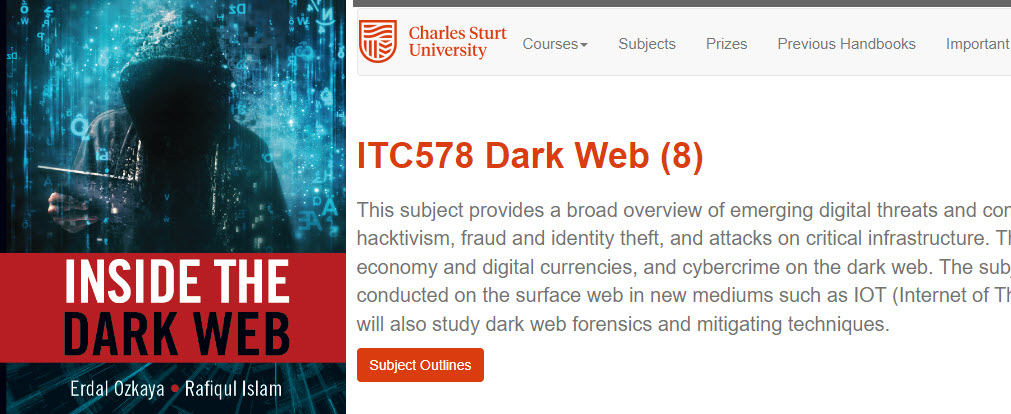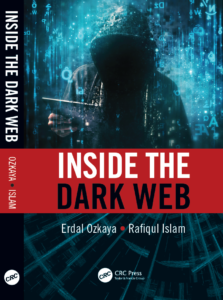
Inside the Dark Web at CSU
Inside the Dark Web at CSU
I am proud to announce that Chales Sturt University is now offering ITC578 Dark Web class as part their university subject. I played an active role on designing the class with Dr Rafiqul Islam which we also authored a book with the same , which is used as Main Course Material.
About ITC578 Dark Web
This subject provides a broad overview of emerging digital threats and computer crimes, with an emphasis on cyber-stalking, hacktivism, fraud and identity theft, and attacks on critical infrastructure. The subject also analyses the online underground economy and digital currencies, and cybercrime on the dark web. The subject further explores how dark web crimes are conducted on the surface web in new mediums such as IOT (Internet of Things) and Peer to Peer file sharing systems. Students will also study dark web forensics and mitigating techniques.
About Inside the Dark Web
This book provides a broad overview of emerging digital threats and computer crimes, with an emphasis on cyber-stalking, hacktivism, fraud and identity theft, and attacks on critical infrastructure. It also analyzes the online underground economy, digital currencies, and cybercrime on the Dark Web.
The book explores how Dark Web crimes are conducted in new mediums, such as IOT and P2P file sharing systems. It starts with the fundamentals of Dark Web and explains the threat landscape of Dark Web. After introducing the TOR browser, it takes a deep dive into cybersecurity criminal activities in the Dark Web, forensics of Dark Web, web content analysis, and threat intelligence.
Table of Contents

1. An Introduction to the Dark Web.
2. Cybercrime and the Dark Web.
3. Malicious Software.
4. Dark Web Malicious Hacker Forums.
5. Ransomware.
6. Accessing Dark Web Contents.
7. Crypto Market and Cryptocurrency.
8. Threat Intelligence from the Dark Web.
9. Social Engineering in the Dark Web.
10. Products and Vendors in Dark Web Markets.
11. Dark Web Forensics.
12. Open-Source Intelligence.
13. Emerging Trend of Dark-Net and Mitigating Techniques.
14. Hands-on Dark Web.
Where you can get the book
CRC Press: https://www.crcpress.com/Inside-the-Dark-Web/Ozkaya-Islam/p/book/9780367236229
Target: https://intl.target.com/p/inside-the-dark-web-by-erdal-ozkaya-rafiqul-islam-paperback/-/A-76551768
Amazon: https://www.amazon.com/Inside-Dark-Web-Erdal-Ozkaya-ebook/dp/B07RXLHRF3/
Learning Outcomes
Upon successful completion of this subject, students should:
- be able to differentiate between theoretical and cross-disciplinary approaches to the dark web;
- be able to analyse the evolution of the dark web in the context of emerging crime threats;
- be able to distinguish and classify the forms of cybercriminal activity through the dark web, and the technological and social engineering methods used to undertake such crimes;
- be able to investigate assumptions about the behaviour and role of offenders and victims in the dark web;
- be able to analyse and assess the impact of cybercrime, along with the mitigating techniques used to defend against cybercrime; and
- be able to discuss, analyse and apply dark web-related research and applications.
Syllabus
This subject will cover the following topics:
- Introduction to the dark web and its various threats
- Malicious dark net
- Data analysis of Web content
- Dark web forensics
- Open Source intelligence
Continuing students should consult the SAL for current offering details: ITC578. Where differences exist between the Handbook and the SAL, the SAL should be taken as containing the correct subject offering details.
Sample exam questions
1. Describe with an example of the main differences between Cyberwar and cybercrime.
2. What are the characteristics of malicious software? Why are malicious insiders a focus of security experts?
3. Define cybercrime. Explain, why are cybercrime efforts becoming more targeted?
4. Distinguish between threat analyses on the surface web compared to the Dark Web?
5. Describe some positive and negative impacts of the dark web on society.
6. How do most malware spread between computers today?
7. Explain malware as a service (MaaS).
8. Distinguish between virus and worms. What is the role of encryption in the operation of a virus?
9. What is spyware? List some of the recent spyware with an example.
10. What are the limitations of Static malware analysis technique?
11. List the terms that relate to the cyber-criminal behaviour involving computers.
12. What is extortion? How do criminals engage in online extortion?
13. Explain how ToR networks work and how does ToR browser differ from any normal browser?
14. Explain how Tor maintains anonymity during web browsing.
15. Describe the anonymous routing of network traffic using Tor.
16. Describe some potential challenges of the Tor network concerning traffic analysis.
17. Briefly explain the general categories of cybercriminals in modern society.
18. Explain the general categories of cybercriminals and their impact on online services.
19. Distinguish between the surface web and the Deep Web in terms of threat intelligence.
20. What do you mean by the term terrorists, corporate spies, and criminals?
21. What do you mean by Hacking? List some of the key characteristics of hackers.
22. What is hacking? Give some examples of the most common hacking technique.
23. What is web mining? Distinguish between web content mining and web structure mining.
24. Explain the method of information extraction from the Dark Web
25. What are the risks associated with collecting and analysing the dark web data?
26. Explain with an example of hacktivists and pleasure seekers.
27. Define with an example the traditional and contemporary techniques used by organized crime groups.
28. Explain with an example of the technique used in social engineering.
29. Explain with an example of the social engineering attack technique?
30. Describe the term Checkpoint firewall log and the Net screen firewall log.
31. Explain the process of information extraction from the Dark Web.
32. List the techniques used to extract evidence from the forensic of TOR browser.
33. What is digital forensics? List various ranges of computer forensics.
34. What is Tor forensic? How can it differ from bitcoin forensic?
35. What is Dark Web forensics? Explain with the expelling of forensic analysis of web attacks.
36. What is OSINT? Why OSINT so important?
37. What are the advantages of OSINT?
38. What do you mean by security intelligence (SI)? What is the difference between log management and risk management in SI?
39. Explain the continuity of darknet marketplace?
40. What is Google Hacking? Give an example of a google hacking command and explain it.
Handbook of ITC578, click here
Which courses will cover Inside the Dark Web
Graduate Certificate in Cyber Security
Subject Overview Abstract
This subject provides a broad overview of emerging digital threats and computer crimes, with an emphasis on cyber-stalking, hacktivism, fraud and identity theft, and attacks on critical
infrastructure. The subject also analyses the online underground economy and digital currencies, and cybercrime on the dark web. The subject further explores how dark web crimes are conducted on the surface web in new mediums such as IOT (Internet of Things) and Peer to Peer file sharing systems. Students will also study dark web forensics and mitigating techniques
About CSU
We believe wisdom transforms communities. With tenacity, we help to shape resilient, sustainable regions for the future. Acknowledging the culture and insight of First Nations Australians, our ethos is clearly described by the Wiradjuri phrase, yindyamarra winhanganha, meaning the wisdom of respectfully knowing how to live well in a world worth living in.
Our vision and values
Our mission is to build skills and knowledge in our regions. We offer choice and flexibility to students and work hand-in-hand with our industries and communities in teaching, research and engagement. Growing from our historical roots, we share our knowledge and expertise as a significant regional export industry and we bring strength and learning from this back to our regions.
Through our values, we create a welcoming community experience and learning environment that supports innovative research, advances society and gives back to our regions.
To see my other books click here





